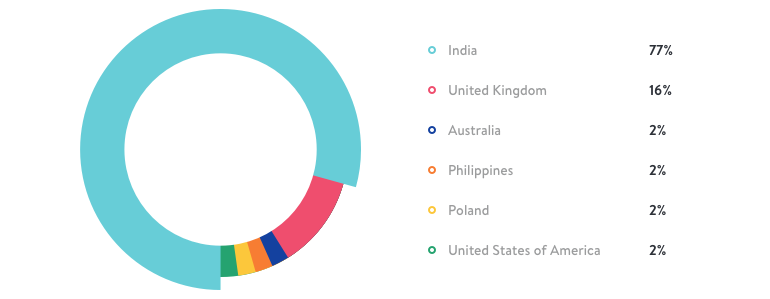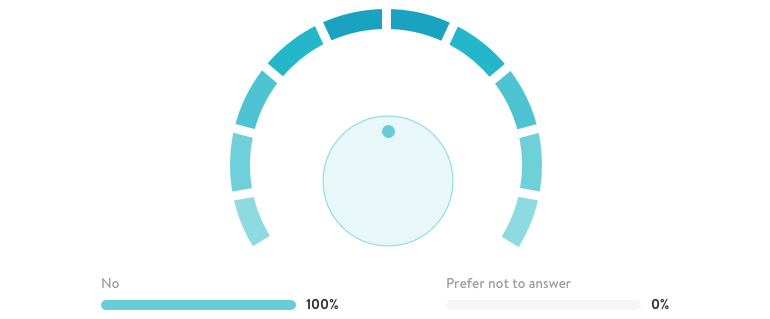At Kayako, we’ve always been concerned with building our company as diverse and inclusive as possible. It’s in our DNA as well as our mission.
We always thought that—because over half of our employees are based in India—we’re doing well on the diversity front by default. We also knew we’re not doing any better than your average tech startup in gender (and some other areas) and we’ve made deliberate efforts from day one to improve.
Finally, at the end of 2017, we ran a short internal demographic survey. We asked questions about gender (and identification), age, nationality, race/ethnicity, location as well as those about disabilities.
An honest look inside Kayako’s diversity and inclusion
To understand results further:
- We’ve split the answers into departments: Tech, Non-Tech, Leadership, and Overall
- And we thought it relevant to break up by two office locations: London, UK, and Gurgaon, India.
61 out of 69 Kayako employees filled in the survey at the end of last year and even though we had a pretty good idea where we stand, we found the results a little….underwhelming.
1. Gender Identity:

2. Age group:

3. Nationality:

4. Location of work:

5. Race/ethnicity:

6. Marital status:

7. Children:

8. Disability:

9. LGBTQIA+:

10. Department of work:

In Kayako, we fail on a diverse and inclusive culture when it comes to age and race. It’s alarming because we learned that:
- We employ one single person of black origin.
- Only 25% of our workforce is female and we employ one single female engineer.
- We have no-one who identifies as gender non-binary.
So, clearly, we’re not where we want to be. We recognize that we’ve been taking steps to move in the right direction, and we are continuously developing concrete plans for further improvement. But we are far from there.
We try our best. And we’re still small enough to be able to glance at where we stand on diversity. But we never really ran any numbers. So we never really knew where we stand. Until we ran our recent survey.
Let’s break it down by our offices located in London, UK, and in Gurgaon, India.
In London, we have a reasonably diverse workforce when it comes to age and gender, but not at all that diverse when it comes to race. This is mind boggling, when you consider the diversity of the city we live in.
In India, we’re not doing particularly well on age or race. Age is a tricky one to analyze. We hire most of our back-end engineers in India and they tend to be younger. Lack of diversity on race could be explainable by the fact that Gurgaon isn’t as diverse as London. Almost everyone you encounter will be South Asian by default.
Yes, both our founders are male but at a time when our leadership team was bigger, we were able to say it had a 50:50 gender representation. Today, gender stands at about average for a technology company and we employ no-one with a disability, anywhere.
We have always tried to take active steps to remove any bias in the hiring process. We value diversity of thought and backgrounds and we look to hire genuine people who will push our culture to be more inclusive and more human. We never knowingly discriminate and we take active steps to advertise far and wide. And yet, our Team page doesn’t look the way we’d want it to.
Still, here are all the steps we’ve taken so far:
- We’ve put in place processes and policies that support equal opportunities. These aren’t simply words on a document.
- We write our job specs in a gender neutral language and we don’t discriminate based on gender, age, religious beliefs or sexual preference.
- We operate a fixed salary structure, which means that two people contributing to our company in the same role at the same level receive equal pay and comparable progression opportunities, regardless of their gender, age, etc.
- When we introduced our staff benefits, we took extra care to ensure that they are inclusive: childcare vouchers, generous parental & adoption leave, sick leave, unlimited holidays and others.
- Our office is wheelchair accessible and our team events don’t revolve around sports and beer only.
- We have a visa sponsorship licence so that we can hire people from outside the EU. To avoid unconscious bias in our hiring process, we use standardised application review – we ask a set of questions on the application form, so that the reviewer’s initial assessment is based on easily compared answers and we us the CV as a secondary source of information.
- We are (in the process of getting) Living Wage accredited and don’t offer unpaid internships.
- We support any initiative by our employees that would bring us one step closer to creating a truly diverse and inclusive company.
- We’re a proud signatory of The Tech Talent Charter and we support organizations that are changing the ratio, like AlterConf, Sanctus, 2020Shift, POCIT and more.
@techcharteruk are pleased to announce @Kayako as a proud signatory of #techtalentcharter helping to drive diversity in tech. Find out how to become a signatory of the Tech Talent Charter here https://t.co/LXbnsCx3HX #womenintech pic.twitter.com/39oz2IZeVD
— TechTalentCharter (@techcharterUK) January 16, 2018
Why we want an inclusive and diverse workforce
The research
There’s a plethora of research to support the notion that ‘diversity is good for business’. According to McKinsey’s Why diversity matters report:
- Ethnically-diverse companies are 35% more likely to outperform financially
- Gender-diverse companies 15% more likely to outperform.
The McKinsey’s follow up report Delivering through Diversity (published in January 2018) reaffirms the global relevance of the link between diversity—defined as a greater proportion of women and a more mixed ethnic and cultural composition in the leadership of large companies—and company financial outperformance.
For gender, the executive team shows the strongest correlation, showing that female-fronted management teams were 21% more likely to make or exceed their profitability goals compared to firms lacking women in decision-making roles. But overall, ethnic diversity was more important than gender diversity, according to the study.
Companies that ranked in the top 25% in terms of the ethnic mix of their executive boards were 33% more likely to be profitable than firms in the bottom 25% for diversity.
Finance aside, more diverse companies also tend to be more innovative, and this is linked to three main reasons:
- Teams with a broader range of people have a wider range of interests, experiences, and backgrounds to draw upon. They understand potential users of products better than less diverse teams. They think about problems in a different way that might have been expected and as a result they tend to be better and more innovative problem-solvers.
- More diverse companies attract and retain more diverse talent. If everyone in your company looks the same then you are cutting yourself off from other types of people – they don’t want to come to work for you.
- More diverse companies have a sort of “halo effect”. They’re more attractive not only to women and minorities, but also to people who are not women or minorities, who want to work for more enlightened organizations.
But a diverse workforce doesn’t always make good business sense. If you’re an early-stage startup, there may be various reasons not to prioritise diversity in the hiring process. There’s time constraints, and budget constraints. There may be lack of resources to hire a diverse team in an industry with a skewed talent pool or there may simply be different priorities that take the front seat. And while these priorities may be valid, these companies should be aware that they’re acquiring a ‘diversity debt’.
Here’s a good article from our friends at Monzo about the diversity debt and what they’re doing to mitigate it.
Our goals and aims
One of our goals has always been to give everyone a greater voice to amplify the good they’re doing in the world. We are very aware that in order to do this, we need diverse voices on our team – a variety of perspectives, experiences, ages, races and ethnicities, abilities, sizes, nationalities and cultures, gender identities and sexual identities, backgrounds, classes, and more.
Our aim is to build an organisation that is collaborative, where you have a voice, have an impact and space for feedback. But conversations about diversity in the workforce need to focus on what underrepresented groups can do for the business, instead of what the business can do for underrepresented groups. For us, a diverse workforce does make good business sense.
Steps, tips, and tricks for Kayako to be more diverse and inclusive
In our quest to create a more diverse team and a more inclusive environment for all, we devised a list of promises:
- We’re committed to equitable salaries that are fair for all.
- We seek talented teammates from all over the world.
- We strive to use language that’s welcoming to all.
- We practice empathy, truly making the effort to listen and understand. Show kindness, and value different perspectives, experiences, and ideas.
- We do our utmost to recognize and combat unconscious bias.
- We support families of all types.
- We encourage everyone to bring their whole authentic self to work.
- We are committed to create safe spaces for everyone to be able to have difficult conversations.
- We amplify and elevate each other.
- We encourage everyone to share their knowledge to build our teammates’ skills and abilities. We want everyone to be open to learning as much as possible.
- We ask everyone to ‘assume positive intent’.
- We encourage people to speak their mind.
- In our careers page update, we’ll make explicit that both our offices are wheelchair accessible, provide details on the usual format of our interview process and explain how to notify us of reasonable adjustments we can make to accommodate any disability.
- We will continue to hire for empathy and difference and keep focussing on emphasising diversity of thought in the hiring process.
- We will continue listening to our team to make sure we keep improving.
Join the mission to supercharge your business through diversity and inclusion
Join us on the quest to create a more inclusive workplace for all. Here are some top tips we’ve already taken and you can take too:
Attract people from diverse backgrounds. Advertise your job far and wide, make sure they reach as diverse groups of people as possible. Don’t just recruit people who are different—or hire because of it. Once hired allow them to be different.
For instance create ‘female coded’ job descriptions. Data shows that men will still apply to female coded adverts, while women will not apply for men coded ones. And it’s been well documented that women will only apply if they feel they meet 100% criteria in a job ad, while men are happy applying if they meet 60%.
Be considerate with your language – be it in writing a job spec, speaking in a meeting, or at a team social. Language matters and it’s important to remember this at all times.
Over communicate. Don’t assume everyone understood the message the way it was intended. Ensure to hear the voices. Amplify and elevate each other by repeating each other’s point in meetings to make sure they’re heard.
Be observant of how people are. Correct people when needed. Push for inclusive practises and policies. Be a voice of change in your organisation. Don’t be afraid to speak up.
Talk to underrepresented groups. Don’t assume you know cause you read about it / listened to a talk etc. Everyone’s experience is different. Challenge your own biases, get out of comfort zone, and diversify your circle.
Always be supportive. Believe what you hear. Show people it’s safe to come forward.
And to wrap up, here’s some further ideas we found useful and you may too:
Find other people who are passionate about the diversity. Team up. Introduce diversity swat team and culture committee. Find allies in position of power, find allies in the majority group.
Identify areas you want tackling. Find champions for the specific topic. Gender, sexual orientation, neurodiversity etc. Make a realistic plan, and tackle those issues one step at a time.
Take care of your teams mental health. 12.7% of all sickness absence days in the UK can be attributed to mental health conditions and recently, One World Health Organization report estimated that by 2020 depression may be the second leading cause of disability, surpassed only by certain types of heart disease. Evidence from the Mental Health Foundation suggests that better mental health support in the workplace could save UK businesses up to £8 billion per year. So what can you do? Introduce “Time to Talk” day. Let your employees know it’s ok to take time off to look after their mental health. And educate yourself – here’s a great article to start you off.
Work on reducing unconscious bias. Everyone has unconscious bias. It doesn’t mean they discriminate but you have to do what you can to mitigate it. Be aware of microaggressions.
Get some real statistics. These can be from your own organisation but also wider. This way, you can set goals.
And remember: You can never take the bias out of people fully – but you can take bias out of process. Attract people from diverse backgrounds, not hire because of it. And don’t ever just focus on diversity, make sure you also focus on inclusion.